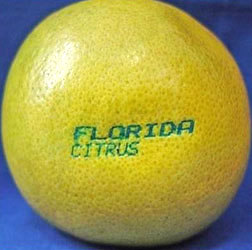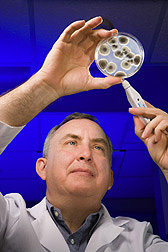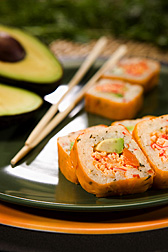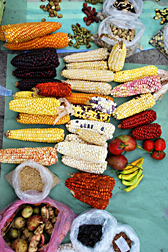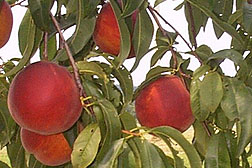| October 2009 |
Water Hardness Plays a Role in Removing Bacteria from Chicken SkinReducing water hardness may increase its ability to remove bacteria from broiler chicken skin, according to Agricultural Research Service (ARS) scientists. After five rinses in very hard, moderately hard, or "soft" water, the soft water removed up to 37 percent more bacteria from the chicken skin than did the other two water types. This included Campylobacter, Staphylococcus and Pseudomonas bacteria. By controlling water hardness, poultry processors may be able to improve the ability of processing water to remove bacteria from the skin of processed poultry. Scientific contact: Arthur Hinton, Jr., (706) 546-3621, ARS Richard B. Russell Research Center, Athens, Ga. |
|
| Food "Tattoos" an Alternative to Labels for Identifying FruitThose small and sometimes inconvenient sticky labels on produce may eventually be replaced by laser "tattoo" technology now being tested by Agricultural Research Service (ARS) and University of Florida scientists. Called "laser etching," the new technology puts a tattoo on grapefruit and other produce so it can be identified at the supermarket checkout lines. Grapefruit has always been labeled with sticky paper labels that can mar the fruit and stick to one another in storage. The labels are also easily removed, making it more difficult to track a piece of produce back to the source if the need arises. This permanent laser etching into the fruit peel does not increase water loss or the entrance of food pathogens or postharvest pathogens if the laser label is covered with wax. Scientific contact: Jan Narciso, (863) 293-4133, ext. 119, ARS Citrus and Subtropical Products Laboratory, Winter Haven, Fla. |
More Frying, Less Fat with New Cooking BatterA new rice batter product developed and patented by the Agricultural Research Service (ARS) absorbs up to 50 percent less cooking oil than traditional batters. The new product is now being marketed by a Maryland company. Users can mix the dry product, called ChoiceBatter, with water before coating and frying foods such as chicken, fish, shrimp, veggies and desserts. The batter can also be used for grilling and baking. The rice flour-based batter is cholesterol- and gluten-free, Kosher, and available over the Internet. Scientific contact: Fred F. Shih, (504) 286-4354, ARS Food Processing and Sensory Quality Research Unit, New Orleans, La. |
|
| Antifungal Pepper Compound Has Potential in Agriculture and MedicineAgricultural Research Service (ARS) scientists and their colleagues have found that a patented antifungal plant compound in cayenne, called CAY-1, holds promise for dual use as an antifungal in both agriculture and medicine. The substance is believed to work by attaching to fungal membranes, where it causes cell components to leak, eventually killing the cell. CAY-1 also may enter fungal cells and adversely affect certain signaling pathways that, in turn, damage the cells' mitochondria. CAY-1 was lethal during the early spore germination cycle of seven tested fungi, but was inactive against dormant spores. Scientific contact: Anthony De Lucca, (504) 286-4253, ARS Food and Feed Safety Research Unit, New Orleans, La. |
Flavorful Fruit and Veggie Wraps Inspire Tasty CreationsAgricultural Research Service (ARS) researchers and entrepreneur Matthew de Bord, founder of Origami Foods, LLC, of Stockton, Calif., are the co-inventors of a patent-pending process to make colorful, paper-thin sheets of edible fruit and vegetable wraps and glazes. The versatile wraps come in flavors like mango, strawberry, tomato-basil, carrot-ginger, and red bell pepper. All of Origami's wraps contain at least 75 to 90 percent fruit or vegetables, and are low in calories, low in fat, and free of additives, preservatives, artificial flavors and artificial colors. The wraps may help kids learn to like the many flavors of fruits and vegetables. Scientific contact: Tara McHugh, (510) 559-5864, ARS Processed Foods Research Unit, Albany, Calif. |
|
| Mapping and Modeling Eastern U.S. Food ProductionAgricultural Research Service (ARS) scientists are mapping an array of county-level data from Maine to Virginia on weather, soil, land use, water availability and other elements. Then they'll use their map to model potential crop production and find out where local food production could meet current and projected demand-and where it won't. Until recently, low fuel prices have contributed to the globalization of the U.S. food system. Relying more on the strategic production of locally grown food could counter the challenges of rising transport costs, growing population demands and vanishing farmlands. The study also will help identify how the costs and benefits of locally grown produce compare with produce that is transported over long distances to the Eastern Seaboard market. Scientific contact: Wayne Honeycutt, (207) 581-3363, ARS New England Plant, Soil and Water Research Laboratory, Orono, Maine. |
ARS Helps Preserve Indigenous Crops in EcuadorAn Agricultural Research Service (ARS) scientist is working with an international group of researchers on a project to improve the livelihoods of people in rural Ecuador by promoting the conservation and use of indigenous crops. People in and around Cotacachi, in the northern Andean highlands, have been farming for thousands of years, and the result is a stunning diversity of crops, some of them little known outside the Andes. But many people now work away from their farms, prompting concerns that some of the crops, along with the associated cultural traditions, may be lost. As part of that project, scientists at Ecuador's National Department of Plant Genetic Resources have saved samples of much of the crop diversity in their genebank. Farmers also have exchanged seeds at fairs and worked with the scientists to evaluate crop varieties. A food-processing plant was built to package products made with crop varieties provided by a farmers' cooperative. Scientific contact: Karen A. Williams, (301) 504-5421, Plant Exchange Office, ARS National Germplasm Resources Laboratory, Beltsville, Md. |
|
| SummerFest and FlavrBurst Join ARS Peach Variety OfferingsPeach growers and consumers now have two new sweet, juicy, yellow-flesh peaches to add to their list of favorite varieties. SummerFest is a high-quality freestone peach with an excellent balance of sweetness and acidity. Harvested in the middle of peach season (mid-August in the Mid-Atlantic states), SummerFest has good firmness, which is important for shipping. FlavrBurst is another high-quality freestone peach that has a good amount of sweetness, but is lower in acidity than typical peach varieties. It may be more suitable for those who cannot tolerate acidic fruits, but still desire a "peachy" flavor. FlavrBurst also has good firmness at harvest maturity. Scientific contact: Ralph Scorza, (304) 725-3451, ext. 322, ARS Appalachian Fruit Research Station, Kearneysville, W.Va. |



